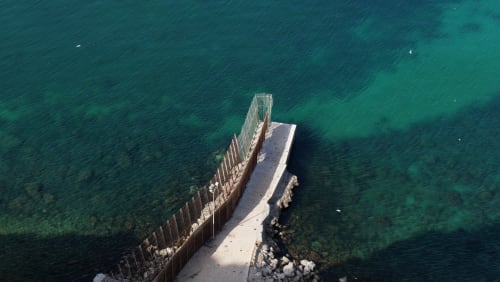|
Slought is pleased to announce Borders Without End, an installation about borders, the power structures they enact, and how to question them, on display from January 18 - February 11, 2022.
The exhibition features the work of Elaine Byrne, Lawrence Abu Hamdan, Camel Collective and others, and builds upon the exhibition Worlds Without End: Stories Around Borders, organized by Michael Dempsey and Sara Reisman for the Hugh Lane Gallery in Dublin, Ireland (2020/2021). A series of artist talks will take place online on Friday, January 28, 2022, followed by an online symposium on Friday, February 4, 2022, that seeks to rethink bordering practices and their effects (more information forthcoming). Please note visitors are required to schedule a reservation through Eventbrite prior to arrival and follow our COVID-19 visitation guidelines.
The subject of borders animates contemporary political discourse, playing a strategic role in the world's fabrication. The modern cartographical representation of the border as a geographical line has obscured the complexity of the border by masking the multiplication of different types of borders and the ways they intersect and engage with each other. The fall of the Berlin Wall signalled a new era of cross-border unity and understanding. Celebrating its collapse, German President Horst Koehler pronounced that the "edifice of fear" had been replaced by a "place of joy," opening up the possibility of a "cooperative global governance which benefits everyone." But the opposite happened; these edifices of fear, both real and imaginary, are being built everywhere.
Borders are complex social institutions that connect and divide and cannot be described simply in terms of exclusion/inclusion. Insofar as borders make divisions and establish connections, they are epistemological devices. As Sandro Mezzadra and Brett Neilson argue in Border as Method, or, The Multiplication of Labor (2013), borders are essential to the way we live because they facilitate the conceptual taxonomies that structure the movement of thought; these conceptual borders often intertwine with geographical borders and have great philosophical relevance. Moreover, in The Borders of Europe (1998), Étienne Balibar remarks that borders are not necessarily where they are supposed to be according to the modern geopolitical imaginary: "borders [...] are no longer at the border, an institutionalized site that could be materialized on the ground and inscribed on the map, where one sovereignty ends, and another begins." For Balibar, far from disappearing, borders are being "multiplied and reduced localization, [...] thinned out and doubled, [...] no longer the shores of politics but [...] the space of the political itself."
The notion that borders have undergone some sort of transformation in their nature and location, and that the modern political subject is also shaped by borders, is a central preoccupation of this exhibition. The works featured in Borders Without End explore the visual paradox of walls, and how that which appears as the articulation of state sovereignty, may actually express its demise relative to other kinds of global forces. Here, different types of borders inevitably fold into one another, and the notion of maintaining sharp, contiguous distinctions between anything is impossible and inevitably breaks down.
More at https://slought.org/resources/borders_without_end »
|


